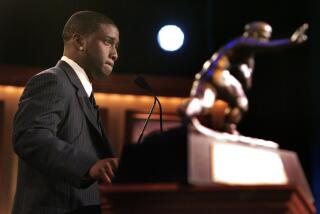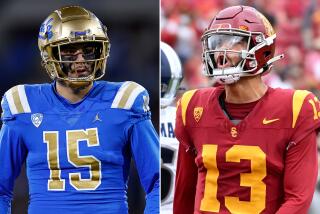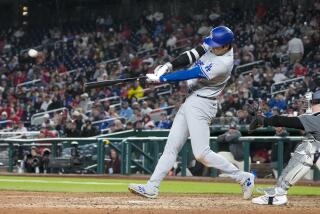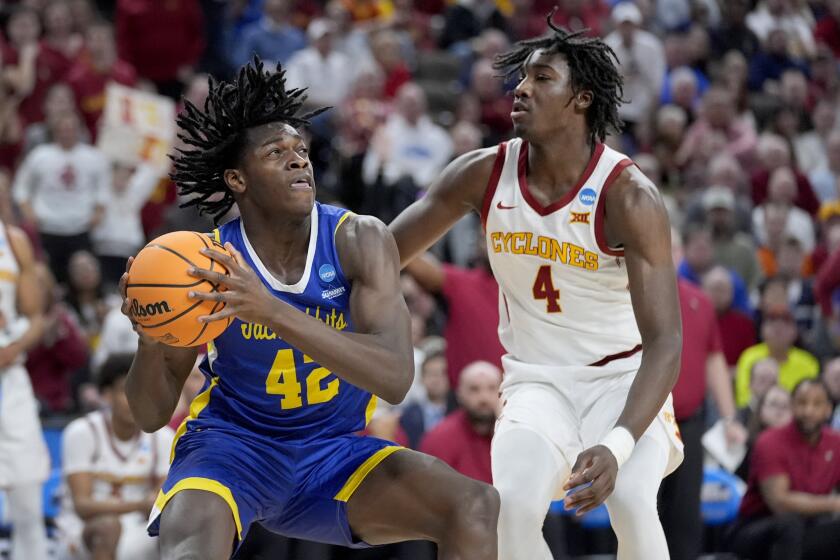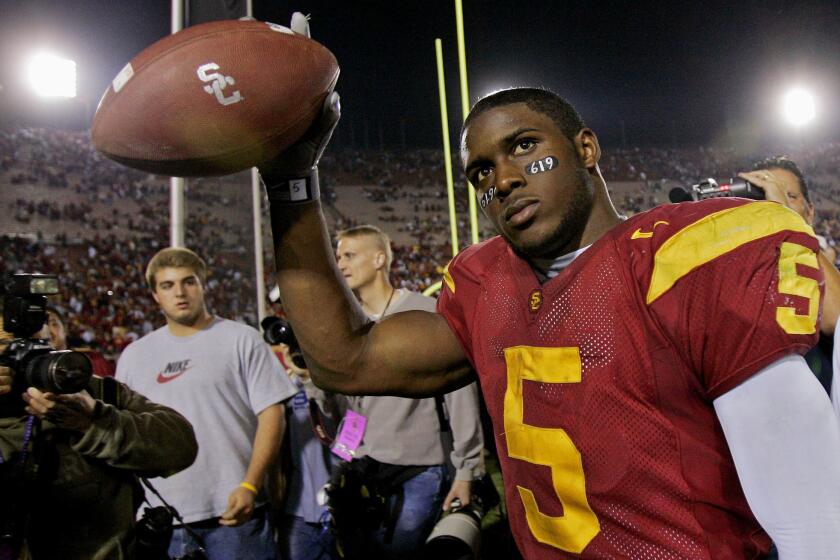O’Malley’s long road to the Hall of Fame
The Baseball Hall of Fame will no doubt recognize Walter O’Malley as the owner who brought the major leagues to the West Coast and made America’s pastime truly national. Yet, after O’Malley was elected to the Hall of Fame on Monday, his son described him as a man whose fondest wish would have been to keep the Dodgers in Brooklyn.
O’Malley delivered the Dodgers to Los Angeles 50 years ago, and the town has embraced the team from Day One. He built a state-of-the-art stadium at his own expense, attracted record crowds, kept ticket prices affordable and delivered a consistent winner, including three World Series championships in his first eight years in town.
The late O’Malley joined former commissioner Bowie Kuhn, former managers Dick Williams and Billy Southworth and inaugural Pittsburgh Pirates owner Barney Dreyfuss in the class of executives and managers elected by the veterans committee Monday. Williams is the only living member of that class, which will be inducted into the Hall of Fame in July.
The players in next year’s Hall of Fame class will be announced in January.
O’Malley, a powerful voice among his peers and a pioneer in efforts to expand baseball beyond the United States, got the minimum nine votes from a 12-member panel. He got less than half the votes from larger panels on two previous ballots, one in 2003 and the other earlier this year.
In explaining why one of the most influential owners in baseball history was not elected until 28 years after his death, his son alluded to the lingering resentment over his departure from Brooklyn.
“Over the years, more and more people have realized the effort my father put into building a stadium in Brooklyn,” said Peter O’Malley, who succeeded his father as the Dodgers’ owner before selling the club in 1997.
“It took him 10 years to decide to move. I don’t think anyone worked harder to keep his franchise in the original city than he did.”
Hall of Famer Tom Lasorda, who played for the Dodgers in Brooklyn and managed the team in Los Angeles, called the election long overdue.
“He linked the entire nation with major league baseball,” Lasorda said.
In a statement, current Dodgers owner Frank McCourt said O’Malley “changed the face of baseball forever.”
O’Malley’s legacy is not defined solely by the transcontinental move and the Dodgers’ pennants. He was a kingmaker, working behind the scenes to oust commissioner Happy Chandler and shepherd successors Ford Frick, William Eckert and Kuhn into power.
In 1962, he opened Dodger Stadium, the first privately financed major league ballpark since Yankee Stadium in 1923 and now a Los Angeles landmark.
“That opened a lot of eyes, that a modern stadium could be as attractive as it is,” Peter O’Malley said. “It looks good to this day.”
He led efforts to popularize the sport internationally, sending the Dodgers on exhibition tours abroad and inaugurating exchange programs for foreign teams and coaches. He turned an abandoned military facility in Vero Beach, Fla., into Dodgertown, one of the most storied spring training complexes.
And his strong support of integration -- well beyond Jackie Robinson, who broke the color barrier with the Dodgers in 1947 -- was in evidence even in his little touches.
Blacks could not play on the golf course in Vero Beach, Lasorda said, so O’Malley built another course at Dodgertown.
O’Malley did his fair share of deal-making just to get into ownership. He joined the Brooklyn Dodgers as general counsel in 1941, at age 37. He bought a minority share in the franchise three years later and gained controlling interest in 1950, buying out legendary executive Branch Rickey in the process.
In 30 years under O’Malley’s control, the Dodgers finished first or second 20 times, including 11 National League pennants and four World Series championships.
Even as the Dodgers prospered on the field, O’Malley explored options for a new ballpark. In 1946, he asked architect Emil Praeger for “some ideas about enlarging or replacing our present stadium.” O’Malley ultimately would retain Praeger to design Dodger Stadium.
O’Malley eventually proposed replacing Ebbets Field with a domed ballpark, a decade before Houston’s Astrodome opened as the world’s first domed stadium. As he negotiated with the Brooklyn officials who ultimately rejected his plan, he learned that New York Giants owner Horace Stoneham planned to move his team to Minneapolis in 1958.
O’Malley persuaded Stoneham to move to San Francisco instead, transplanting the Dodgers’ National League rival to California. After the 1957 season, O’Malley announced the Dodgers would move to Los Angeles, at a time baseball called Chicago and St. Louis western outposts.
“The West Coast was so far away in those days,” said Lasorda, who played for the Los Angeles Angels, the minor league franchise displaced by the arrival of the Dodgers. “It was like the other end of the world to me.”
The Giants left New York at the same time as the Dodgers, and in the previous five years the Boston Braves had moved to Milwaukee, the St. Louis Browns to Baltimore and the Philadelphia Athletics to Kansas City.
None of those moves drew the prolonged wrath that O’Malley endured for taking the Dodgers out of Brooklyn. The borough never did attract another major league team to replace “Dem Bums,” celebrated in literature -- as “The Boys of Summer” -- and in song. At one point Monday, a headline on the New York Times’ website proclaimed, “Brooklyn Villain is Now a Hall of Famer.”
But Brooklyn might be getting on with its life. Joan Hodges, the widow of former Dodgers star Gil Hodges, still lives in Brooklyn. She told The Times earlier this year that folks there now blame former city commissioner Robert Moses as well.
“People realize it was Moses, not Walter O’Malley,” she said. “They come up to me now and say they almost feel like they have to apologize. I tell them it’s never too late.”
The New York Mets’ new stadium, scheduled to open in 2009, will resemble Ebbets Field. Willie Randolph, 53, the manager of the Mets, grew up in Brooklyn and calls the Mets “my hometown team.” The NBA’s New Jersey Nets are scheduled to move to Brooklyn, near the very site O’Malley proposed for his new ballpark a half-century ago.
And even though Peter O’Malley sold the Dodgers a decade ago, his family remains involved in baseball. Tom Seidler and his cousin Kevin O’Malley -- two grandsons of Walter O’Malley -- are the majority owners of the Visalia Oaks, a minor league team. The other partners are family members.
Seidler, 39, was in attendance here when his grandfather’s election to the Hall of Fame was announced.
“He was a visionary for baseball and set a good example for all of us,” Seidler said. “I’m just excited. I’m extremely proud.
“All of us were fortunate to grow up around baseball. I have memories of Dodgertown when Walter was still alive. As a family, we used to go to Dodgertown in the spring,” Seidler said.
“We used to light bottle rockets in front of Dodger Stadium. All of us learned to drive in the Dodger Stadium parking lot.”
More to Read
Get our high school sports newsletter
Prep Rally is devoted to the SoCal high school sports experience, bringing you scores, stories and a behind-the-scenes look at what makes prep sports so popular.
You may occasionally receive promotional content from the Los Angeles Times.
